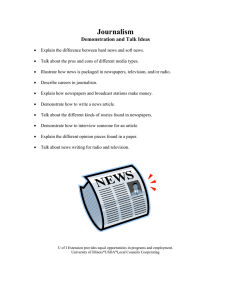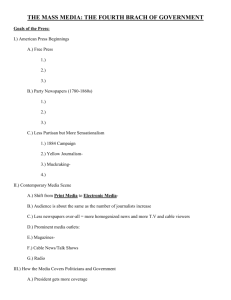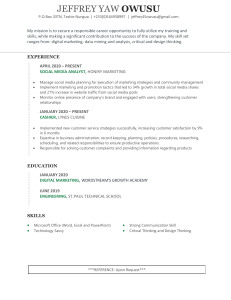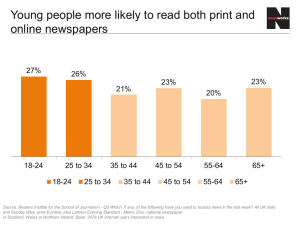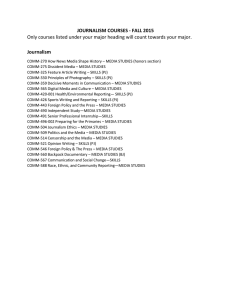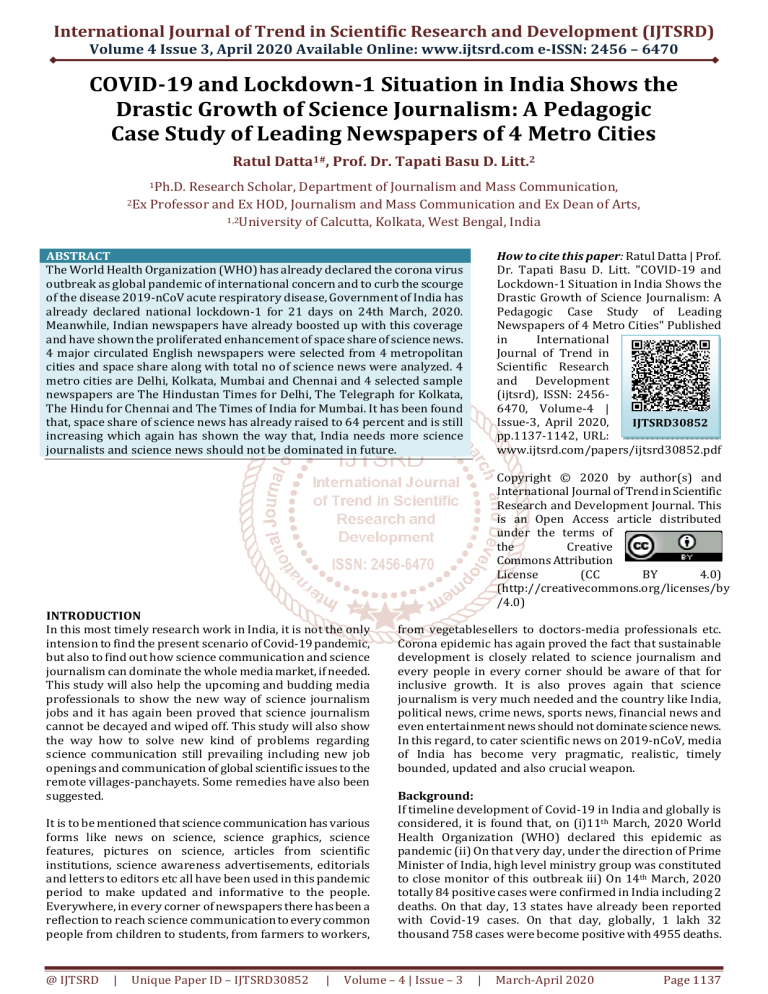
International Journal of Trend in Scientific Research and Development (IJTSRD)
Volume 4 Issue 3, April 2020 Available Online: www.ijtsrd.com e-ISSN: 2456 – 6470
COVID-19 and Lockdown-1 Situation in India Shows the
Drastic Growth of Science Journalism: A Pedagogic
Case Study of Leading Newspapers of 4 Metro Cities
Ratul Datta1#, Prof. Dr. Tapati Basu D. Litt.2
1Ph.D.
2Ex
Research Scholar, Department of Journalism and Mass Communication,
Professor and Ex HOD, Journalism and Mass Communication and Ex Dean of Arts,
1,2University of Calcutta, Kolkata, West Bengal, India
ABSTRACT
The World Health Organization (WHO) has already declared the corona virus
outbreak as global pandemic of international concern and to curb the scourge
of the disease 2019-nCoV acute respiratory disease, Government of India has
already declared national lockdown-1 for 21 days on 24th March, 2020.
Meanwhile, Indian newspapers have already boosted up with this coverage
and have shown the proliferated enhancement of space share of science news.
4 major circulated English newspapers were selected from 4 metropolitan
cities and space share along with total no of science news were analyzed. 4
metro cities are Delhi, Kolkata, Mumbai and Chennai and 4 selected sample
newspapers are The Hindustan Times for Delhi, The Telegraph for Kolkata,
The Hindu for Chennai and The Times of India for Mumbai. It has been found
that, space share of science news has already raised to 64 percent and is still
increasing which again has shown the way that, India needs more science
journalists and science news should not be dominated in future.
How to cite this paper: Ratul Datta | Prof.
Dr. Tapati Basu D. Litt. "COVID-19 and
Lockdown-1 Situation in India Shows the
Drastic Growth of Science Journalism: A
Pedagogic Case Study of Leading
Newspapers of 4 Metro Cities" Published
in
International
Journal of Trend in
Scientific Research
and Development
(ijtsrd), ISSN: 24566470, Volume-4 |
Issue-3, April 2020,
IJTSRD30852
pp.1137-1142, URL:
www.ijtsrd.com/papers/ijtsrd30852.pdf
Copyright © 2020 by author(s) and
International Journal of Trend in Scientific
Research and Development Journal. This
is an Open Access article distributed
under the terms of
the
Creative
Commons Attribution
License
(CC
BY
4.0)
(http://creativecommons.org/licenses/by
/4.0)
INTRODUCTION
In this most timely research work in India, it is not the only
intension to find the present scenario of Covid-19 pandemic,
but also to find out how science communication and science
journalism can dominate the whole media market, if needed.
This study will also help the upcoming and budding media
professionals to show the new way of science journalism
jobs and it has again been proved that science journalism
cannot be decayed and wiped off. This study will also show
the way how to solve new kind of problems regarding
science communication still prevailing including new job
openings and communication of global scientific issues to the
remote villages-panchayets. Some remedies have also been
suggested.
It is to be mentioned that science communication has various
forms like news on science, science graphics, science
features, pictures on science, articles from scientific
institutions, science awareness advertisements, editorials
and letters to editors etc all have been used in this pandemic
period to make updated and informative to the people.
Everywhere, in every corner of newspapers there has been a
reflection to reach science communication to every common
people from children to students, from farmers to workers,
@ IJTSRD
|
Unique Paper ID – IJTSRD30852
|
from vegetablesellers to doctors-media professionals etc.
Corona epidemic has again proved the fact that sustainable
development is closely related to science journalism and
every people in every corner should be aware of that for
inclusive growth. It is also proves again that science
journalism is very much needed and the country like India,
political news, crime news, sports news, financial news and
even entertainment news should not dominate science news.
In this regard, to cater scientific news on 2019-nCoV, media
of India has become very pragmatic, realistic, timely
bounded, updated and also crucial weapon.
Background:
If timeline development of Covid-19 in India and globally is
considered, it is found that, on (i)11th March, 2020 World
Health Organization (WHO) declared this epidemic as
pandemic (ii) On that very day, under the direction of Prime
Minister of India, high level ministry group was constituted
to close monitor of this outbreak iii) On 14th March, 2020
totally 84 positive cases were confirmed in India including 2
deaths. On that day, 13 states have already been reported
with Covid-19 cases. On that day, globally, 1 lakh 32
thousand 758 cases were become positive with 4955 deaths.
Volume – 4 | Issue – 3
|
March-April 2020
Page 1137
International Journal of Trend in Scientific Research and Development (IJTSRD) @ www.ijtsrd.com eISSN: 2456-6470
(iii) Janata Curfew was already called for and on 22nd
March,2020 i.e. just before the national lockdown
declaration in the history of India, total figure of India was
raised to 360 in total with 7 deaths and 23 states were
already been affected. iv) For the 1st time in Indian history,
National Lockdown-1 was declared for 21 days under
section 6(2) (i) of Disaster Management Act, 2005. On that
day, India had 909 active cases with 19 deaths in 27 states
and union territories. On that very day, globally, 20, 834
death figure was confirmed along with 4,46, 684 positive
cases v) After video conferencing and consultation with all
chief ministers of every state of this country, Prime Minister
declared the extension of National Lockdown-1 to National
Lockdown-2, till 3rd May, 2020.
Graph 1: WHO-India Novel Coronavirus Disease situation report shows states and district reporting COVID-19 as
on 28th March, 2020 after declaration of National Lockdown-1 in India (Source)
Graph 2: WHO-India Novel Coronavirus Disease situation report shows new and cumulative cases of reporting of
COVID-19 as on 12th April, 2020 just before declaration of National Lockdown-2 in India (Source)
@ IJTSRD
|
Unique Paper ID – IJTSRD30852
|
Volume – 4 | Issue – 3
|
March-April 2020
Page 1138
International Journal of Trend in Scientific Research and Development (IJTSRD) @ www.ijtsrd.com eISSN: 2456-6470
Graph 3: WHO-India Novel Coronavirus Disease situation report shows new and cumulative cases of reporting of
COVID-19 as on 19th April, 2020 just after declaration of National Lockdown-2 in India (Source)
Present scenario of science journalism in India:
Till today, there is a huge difference between very high development indexed countries in the world and mid level development
(India belongs to this group, according to UN Development report, 2018) indexed country in quality and quantity of science
journalism. Here, still, space share of science news is just 3.5-4 per cent, according to last published research, before the
publication of coverage of Covid-19, in India. Also present situation is, 1st page news on science, editorial on science, experts
views from scientific fraternity etc are the rarest cases in India, that has already achieved by Indian media, within Lockdown-1
period.
Research methodology and research design:
It is a formulative as well as applied research work as under different scientific formulation, space share of different science
news on COVID-19 were collected, analyzed, categorized and formulated statistically. It is also a social research as various
factors and variables are very much related to social development. This research is empirical as it is based on different
measurement analysis. It is also a comparative research work as this research shows the comparative study among some
factors.
Time period for this research work was considered as Lockdown Period-1 i.e. from 24th March, 2020 to 14th April, 2020 i.e. 21
days. For sample survey, 4 major metro cities, Delhi, Kolkata, Chennai and Mumbai were considered. 4 selected sample
newspapers were The Hindustan Times for Delhi, The Telegraph for Kolkata, The Hindu for Chennai and The Times of India for
Mumbai.
Statistical analysis and theoretical framework of research:
It is always found in almost all newspapers of India, that, on an average, political news, followed by sports news, crime news,
entertainment news, news on administrative decisions etc dominate science news and hence, within this lockdown-1 time
period, all day, all newspapers were analyzed and space share were measured according to colume-cm. Then space share of
science news on Covid-19 were compared with other types of news and were tabulated below in table 1. Also table 2 will show
the comparative percentage of space share of 10 different types of scientific news on Covid-19 in 3 consecutive weeks of
National Lockdown-1 in India.
Table 1: Comparative space share of scientific news on Covid-19 along with other types of news in 3 consecutive
weeks of National Lockdown-1
Crime
Political
Sports
Financial
Entertainment
Administration
News on
News C2
News C3
News C4
News C5
News C6
News C7
Covid-19 C8
1st week of
Lockdown-1
4.1
6.7
9.5
3.4
6.5
4.6
65.2
2nd week of
Lockdown-1
4.7
4.2
8.1
2.6
5.1
2.5
72.8
3rd week of
Lockdown-1
3.0
3.1
7.6
1.9
4.2
1.4
78.8
@ IJTSRD
|
Unique Paper ID – IJTSRD30852
|
Volume – 4 | Issue – 3
|
March-April 2020
Page 1139
International Journal of Trend in Scientific Research and Development (IJTSRD) @ www.ijtsrd.com eISSN: 2456-6470
Table 2: Comparative percentage of space share of 10 different types of scientific news on Covid-19 in 3
consecutive weeks of National Lockdown-1
Graphics on Covid-19
7.2
1st page lead news on Covid-19
91.2
Public understanding of science on Covid-19 34.7 Awareness campaign on Covid-19 17.8
Published research and journal on Covid-19 6.5 Interview of scientists on Covid-19 16.6
Write up/statements of experts on Covid-19 11.1
Editorial on Covid-19
51.6
Pictures on Covid-19
5.6
Letters to the editor and Covid-19 21.3
Graph 4: Vertical cylinder diagram showing comparative space share of science news on
Covid19 during national laockdown period-1
80
60
40
20
0
One-Way Analysis of Variance Report
C8 vs C1
80
75
70
65
1st week of Lockdown-1
2nd week of Lockdown-1
3rd week of Lockdown-1
C1
Box Plot Section
Model Term
DF
Between (C1)
Within (Error)
Adjusted Total
Total
2
0
2
3
Plots of Means Section
Table 3: Analysis of Variance Table and F-Test
Sum of
Mean
Prob
Reject Equal
F-Ratio
Squares
Square
Level
Means? (α=0.05)
92.90667
46.45333
0
92.90667
Welch's Test of Means Allowing for Unequal Variances
Model Term
Numerator DF Denominator DF
Between Groups
2
∞
F-Ratio
0.0000
Prob Level
1
Power
(α=0.05)
Reject Equal Means? (α=0.05)
No
Table 4: Kruskal-Wallis One-Way ANOVA on Ranks
Hypotheses
H0: All medians are equal.
H1: At least two medians are different.
Test Results
Method
Not Corrected for Ties
Corrected for Ties
Number Sets of Ties
Multiplicity Factor
@ IJTSRD
|
DF
2
2
0
0
Unique Paper ID – IJTSRD30852
Chi-Squared (H)
2.0000
2.0000
|
Prob Level
0.3678795
0.3678795
Volume – 4 | Issue – 3
|
Reject H0? (α=0.05)
No
No
March-April 2020
Page 1140
International Journal of Trend in Scientific Research and Development (IJTSRD) @ www.ijtsrd.com eISSN: 2456-6470
Group Detail
Group
1st week of Lockdown-1
2nd week of Lockdown-1
3rd week of Lockdown-1
Count
1
1
1
Sum of Ranks
1.00
2.00
3.00
Mean Rank
1.00
2.00
3.00
Z-Value
-1.2247
0.0000
1.2247
Median
65.2
72.8
78.8
Table 5: Normal Scores Tests
Hypotheses
H0: All group data distributions are the same.
H1: At least one group has observations that tend to be greater than those of the other groups.
Results
Test
Not Corrected for Ties
Corrected for Ties
DF
2
2
Chi-Squared (H)
2.0000
2.0000
Prob Level
0.3678795
0.3678795
Reject H0? (α=0.20)
No
No
Descriptive Statistics
Group
Count(ni)
Mean
Effect
All
A: C1
1st week of Lockdown-1
2nd week of Lockdown-1
3rd week of Lockdown-1
3
72.26667
72.26667
1
1
1
65.2
72.2
78.2
-7.066667
0.5333334
6.533333
Median
Standard
Deviation
Standard Error
√(MSE/ni)
65.2
72.2
78.2
0
0
0
Table 6: Kruskal-Wallis Multiple-Comparison Z-Value Test (Dunn's Test)
1st week of Lockdown-1 2nd week of Lockdown-1 3rd week of Lockdown-1
1st week of Lockdown-1
0.0000
0.7071
1.4142
2nd week of Lockdown-1
0.7071
0.0000
0.7071
3rd week of Lockdown-1
1.4142
0.7071
0.0000
91.2
100
80
60
40
20
0
51.6
34.7
7.2
6.5
11.1
17.8
16.6
5.6
Gr
aph 6: Vertical cylinder diagram showing the percentage of space share of 10 different types of scientific news on
Covid-19 in 3 consecutive weeks of National Lockdown-1
Results and discussion:
From the above table-1 and graph-4 it has been found that,
there has been a stiff increase of percentage of space share of
science news, only due to Covid-19 and people have
aggressively read all those news based on science and hence
all other types of news like crime-political-sports-financialentertainment-administration related news have shared
very small portion of space in newspapers compared to
science news. Also, Graph-4 has shown that in consecutive 3
weeks of national lockdown-1, percentage of space share of
science news has drastically increased and other types of
news have decreased drastically. Graph 6 has shown that, in
almost all day, 1st page lead news was on Covid-19 and
science news have reached 91.2 percent of space share. It
@ IJTSRD
|
Unique Paper ID – IJTSRD30852
|
has also been found that, more than 50 percent editorials
(51.6 percent space share) were on Covid-19 i.e. science.
Within this national lockdown-1, more than 20 percent
letters to the editor (21.3 percent) were on science
journalism related and public understanding of science
related articles-materials etc have achieved nearly one-third
of space (34.7 percent).
Then one-way ANOVA Test was done on the table-1 to find
whether the survey or the experimental results were
significant. It has helped to figure out it is needed to reject
the null hypothesis or accept the alternative hypothesis and
Graph-5 has shown the normality test with plots of mean
Volume – 4 | Issue – 3
|
March-April 2020
Page 1141
International Journal of Trend in Scientific Research and Development (IJTSRD) @ www.ijtsrd.com eISSN: 2456-6470
section. Table 3: Analysis of Variance Table and F-Test. Table
4: Kruskal-Wallis One-Way ANOVA on Ranks. Table 5:
Normal Scores Tests. Table 6: Kruskal-Wallis MultipleComparison Z-Value Test (Dunn's Test).
From Table-4 and Table-6. It has been found that, medians
are not significantly different and the null hypothesis are
been accepted.
Conclusion:
From the above charts and diagrams along with statistical
analysis of ANOVA test, it has been found that, Covid-19 like
global pandemic has shown the way to the media
professionals that, science journalism is still very important
and relevant and should provide more space daily in
newspapers, everyday for total sustainable development of
the nation. It has been proved that, science journalism has
@ IJTSRD
|
Unique Paper ID – IJTSRD30852
|
not been decayed, but situation has shown again that it
should be increased.
REFERENCES
[1] 9) Bader, R.G. (1990). How science news sections
influence newspaper science coverage: A case study.
Journalism Quarterly, 67, 88-89.
[2] 16) Biswas, S. (2012). Why are India’s Media under fire?
BBC News India. Retrieved 12 March 12, 2013, from
http://www.bbc.co.uk/news/world-asia-india16524711
[3] 1. Cohen, J. (1988). Statistical power analysis for the
behavioral sciences. 2nd Edn. Lawrence Erlbaum,
Hillsdale, New Jersey. 567 pp.
[4] WHO Reports on Covid 19 Novel Coronavirus
Volume – 4 | Issue – 3
|
March-April 2020
Page 1142

